If you’ve ever seen a bright yellow spiky fruit in the produce aisle and wondered what it was, you’re in the right place. Pitaya yellow dragon fruit isn’t just beautiful-it’s delicious, hydrating, and full of surprising health benefits. In this article, you’ll discover how it tastes, how to cut and eat it properly, why it’s different from other dragon fruits, and what health perks and risks come with it. Whether you’re new to tropical fruits or already a fan, this is your go-to guide to making the most of pitaya yellow dragon fruit.
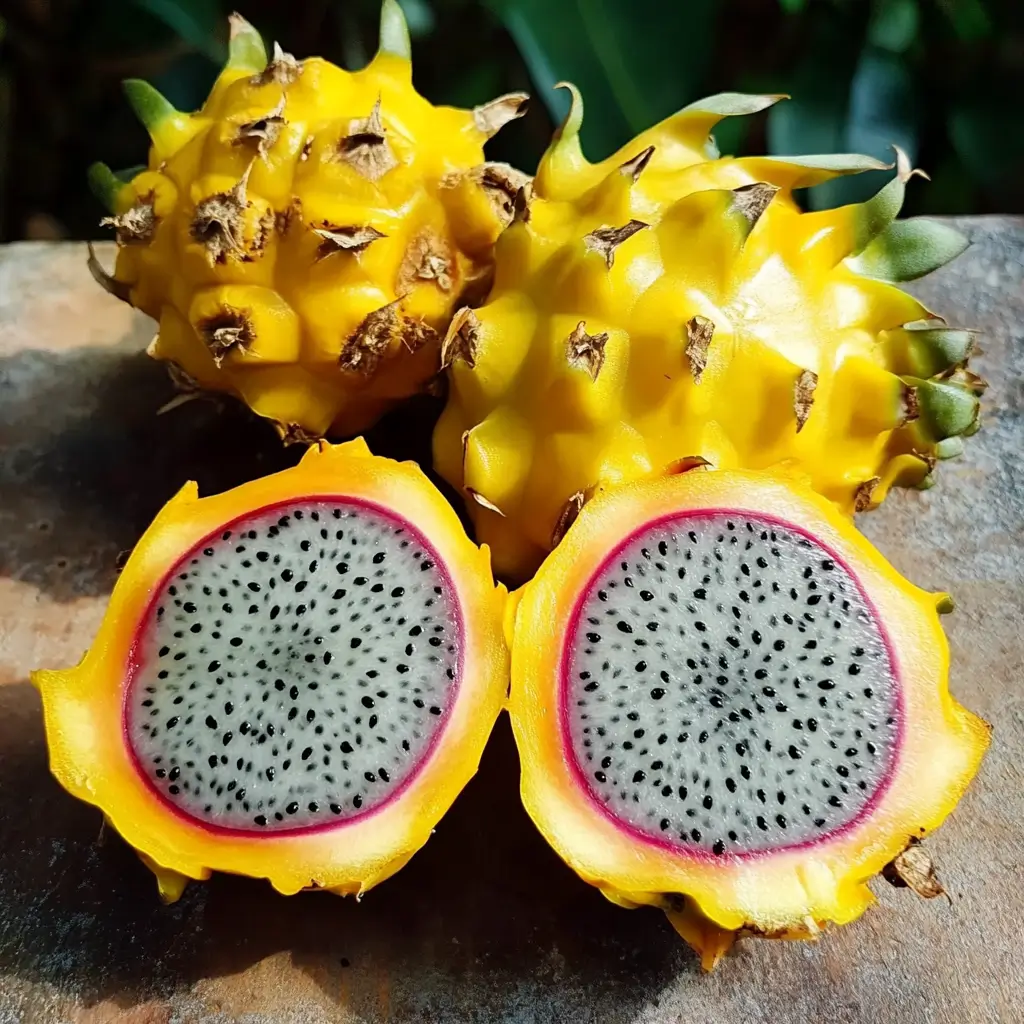
Table of Contents
Why I Fell in Love With Pitaya Yellow Dragon Fruit
A Sweet Memory from My Kitchen
Hi, I’m Sarah. I’ll never forget the day I first tasted pitaya yellow dragon fruit. It was at a small farmer’s market while I was visiting my aunt in Florida. The sun was blazing, and I was on the hunt for something refreshing. One vendor offered me a slice of a fruit I’d never seen before-yellow skin, white flesh, tiny black seeds. I took a bite and couldn’t believe how sweet and juicy it was. It instantly reminded me of my childhood, standing next to my grandma in her kitchen, tasting every fruit she brought home from the market. She always believed in using simple ingredients to make something beautiful, and this fruit fit right into that tradition.
That experience brought me back home to my own kitchen, where I love recreating simple, beautiful recipes with ingredients that surprise you. Pitaya yellow dragon fruit is exactly that-simple but extraordinary.
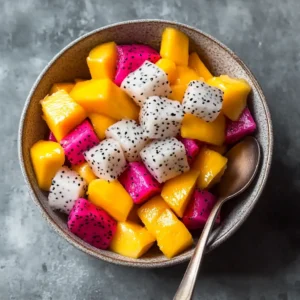
Pitaya Yellow Dragon Fruit: Sweet Health
Ingredients
- 1 ripe yellow dragon fruit
- Optional: 1 tbsp lime juice
- Optional: 1/2 tsp chili powder for a savory twist
Instructions
- Cut the yellow dragon fruit in half lengthwise.
- Scoop out the white flesh using a spoon.
- Enjoy it fresh as-is, or cut it into cubes and chill.
- Optional: drizzle with lime juice or sprinkle with chili powder for extra flavor.
Notes
- No need to peel—the skin isn’t edible, just scoop and eat.
- Naturally sweet, so no extra sugar is required.
- Great as a smoothie base, in fruit bowls, or on yogurt.
Nutrition
Why Pitaya Yellow Dragon Fruit Stole My Heart
There’s something special about the flavor of yellow pitaya. Unlike its red-skinned cousin, this one is sweeter, almost honey-like, with a juicy and crunchy texture that makes it perfect for snacking, smoothies, or even fancy fruit salads. It’s one of those fruits that needs no extra sugar or spices-it shines all on its own.
Not only does it taste amazing, but it’s also packed with good-for-you stuff like fiber, magnesium, and antioxidants. And let’s not forget-it’s one of the prettiest fruits out there. It fits perfectly into the kind of easy, budget-friendly recipes I love sharing on SnacksPrep’s tropical fruit ideas and other simple snack recipes. Even if you’re not a “fruit person,” this one might just change your mind.
This fruit taught me that something can be easy to prepare, affordable, and still feel like a treat. So, let’s dive into why pitaya yellow dragon fruit deserves a spot in your kitchen.
What Makes Pitaya Yellow Dragon Fruit Special
Flavor and Appearance Differences
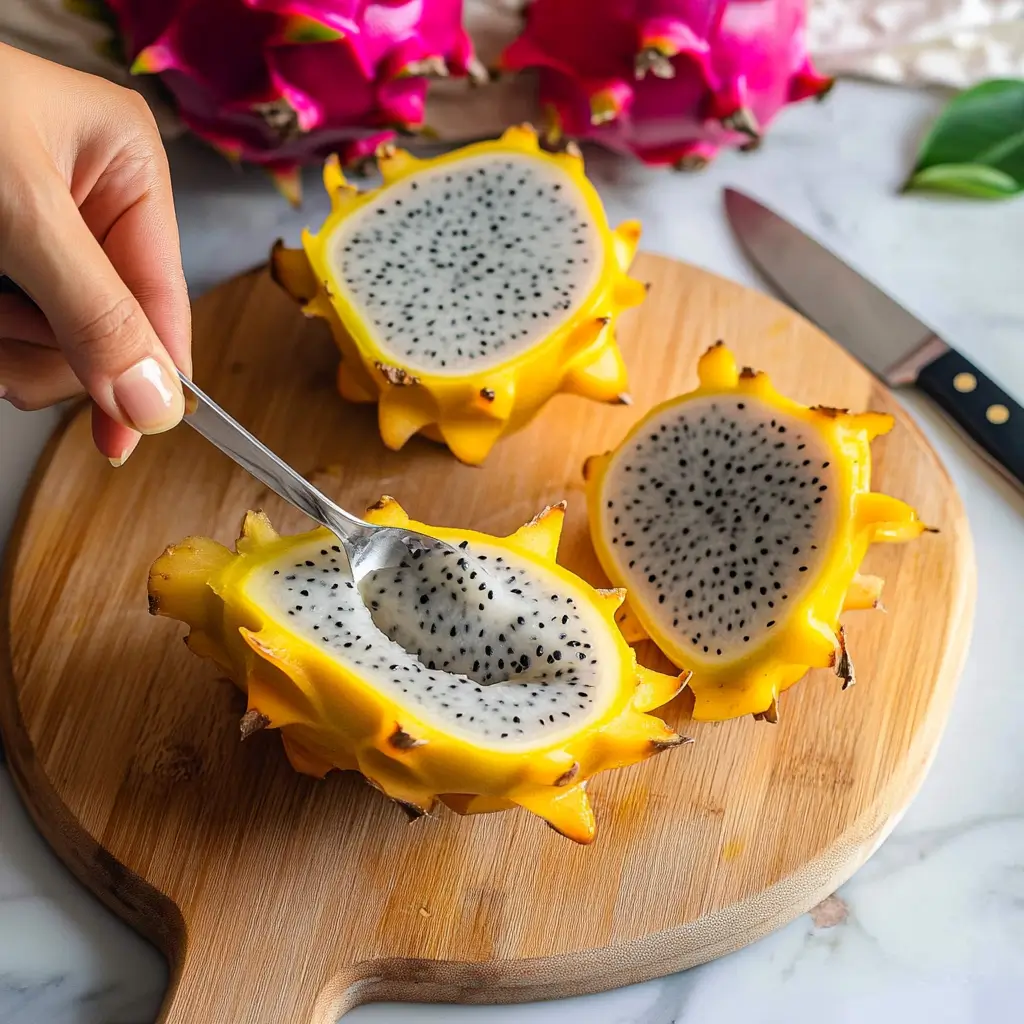
When most people think of dragon fruit, they picture the pink or red-skinned kind. But pitaya yellow dragon fruit is a whole new experience. Its bright yellow outer skin is dotted with small soft spines, and when you slice it open, the inside reveals a white, juicy flesh speckled with tiny black seeds. The taste is where it truly stands out. While red dragon fruit has a mild, sometimes earthy flavor, pitaya yellow dragon fruit is intensely sweet-often compared to honey, pear, or a very ripe kiwi.
Its flesh is slightly firmer than the red variety, yet still scoopable with a spoon, making it incredibly easy to eat. And because of its naturally sweet flavor, it doesn’t need anything extra. You can enjoy it just as it is, or add it to your smoothie bowl, fruit salad, or tropical snack tray. I’ve even included it in some of my naturally sweet snack recipes and it’s quickly become a reader favorite.
Nutritional Breakdown of Yellow Pitaya
This fruit is more than just good looks and flavor-it brings real nutritional value to your table. A single medium-sized pitaya yellow dragon fruit contains about 60 calories, 3 grams of fiber, and generous amounts of magnesium, vitamin C, and iron. It’s also high in water content and antioxidants, which makes it great for hydration and immune support.
To give you a quick comparison, here’s how it measures up against other fruits:
- Yellow dragon fruit: 60 calories, 3g fiber, 15% vitamin C, 18mg magnesium per 100g
- Red dragon fruit: 50 calories, 1.5g fiber, 10% vitamin C, 10mg magnesium
- Kiwi: 61 calories, 2.1g fiber, 154% vitamin C, 17mg magnesium
As you can see, yellow pitaya holds its own. With higher fiber than red dragon fruit and solid vitamin content, it’s a fantastic option for those looking to eat smarter without sacrificing flavor. I often include it in hydrating snacks during warmer months when you need something light, refreshing, and naturally energizing.
How to Eat and Use Pitaya Yellow Dragon Fruit
How to Cut and Eat pitaya yellow dragon fruit
One of the best things about pitaya yellow dragon fruit is how easy it is to prepare. You don’t need any fancy tools or special skills-just a sharp knife and a spoon. Start by slicing the fruit in half lengthwise. Inside, you’ll see the soft white flesh dotted with seeds. From there, you can either scoop it out with a spoon and eat it directly, or cut the halves into quarters and peel back the skin like a banana.
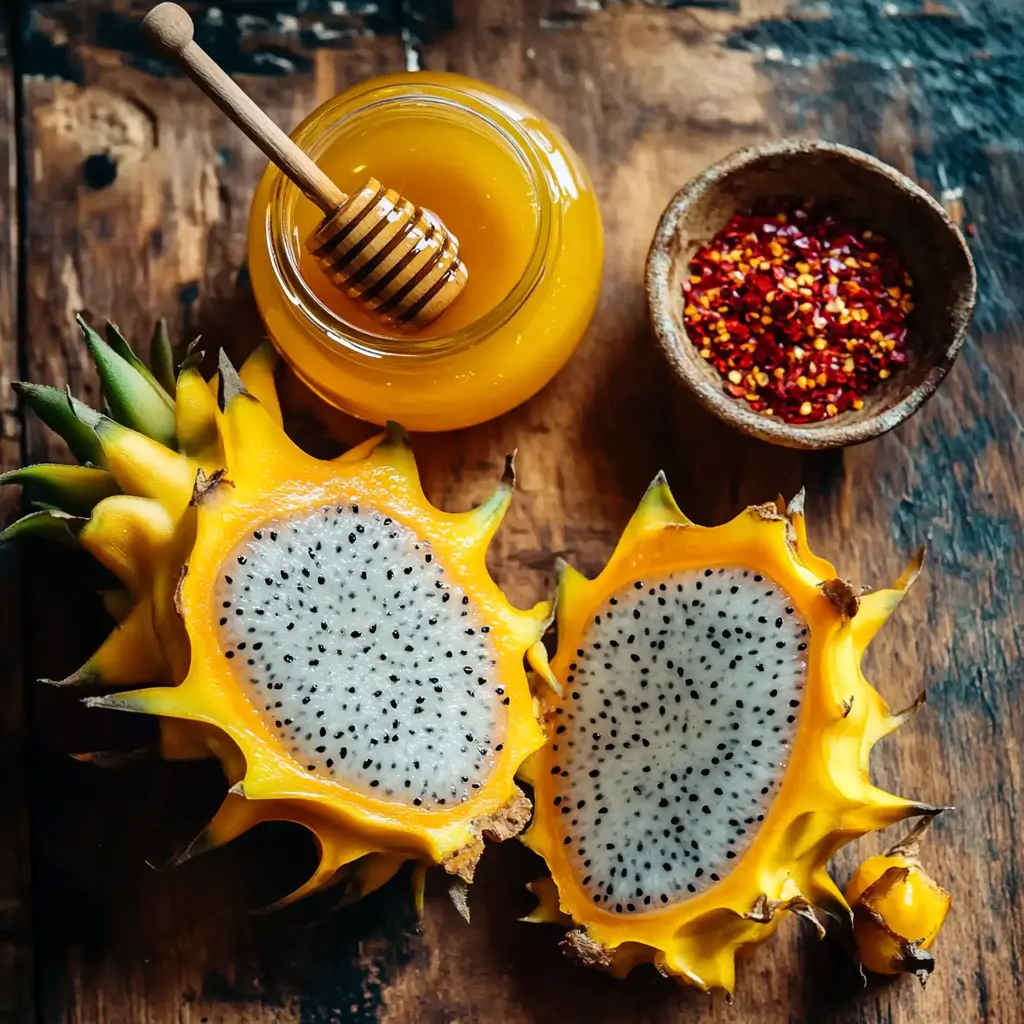
The skin isn’t edible, but the flesh is so sweet and tender that you’ll want to enjoy every bite. Some people cube it and chill it before serving for an extra-refreshing treat. It’s also perfect as a topping on yogurt, granola bowls, or tossed with other fruits in a tropical salad. At SnacksPrep, I often use it as a natural sweetener in breakfast bowls and desserts that don’t rely on refined sugar.
If you’re feeling fancy, freeze the scooped flesh and blend it with banana or coconut milk to create a quick, no-added-sugar sorbet. You can even pair it with savory snacks like spiced roasted chickpeas for a balanced, fun combo.
Creative Ideas to Use in Meals
While eating it fresh is a treat in itself, pitaya yellow dragon fruit is also a versatile ingredient for recipes. It blends beautifully into smoothies, thanks to its natural sweetness. One of my favorite combos is yellow pitaya, mango, and coconut milk. You don’t need to add sugar-it’s already like drinking sunshine.
You can dice it and add it to salsa with lime juice and jalapeño for a sweet-spicy kick, or layer it into parfaits with Greek yogurt and granola. For a colorful weekend brunch, try it as a topping for pancakes or waffles, right next to your favorite nut butter or maple syrup.
If you love hosting, use cubed yellow pitaya as part of a vibrant fruit platter with watermelon, pineapple, and kiwi. It’s a crowd-pleaser and adds that exotic touch that gets everyone talking. For more ideas on how to turn simple ingredients into show-stopping snacks, don’t miss the easy snack board inspirations I’ve shared that mix sweet, savory, and tropical vibes all in one.
Health Perks and Things to Watch Out For
Top Health Benefits of pitaya yellow dragon fruit
Pitaya yellow dragon fruit isn’t just a treat for your taste buds-it’s a powerhouse of nutrients that can truly support your well-being. One of its most celebrated benefits is how great it is for digestion. Thanks to its high fiber content, this fruit helps keep your digestive system running smoothly. Just one serving can gently support gut health and reduce bloating, making it perfect as a midday snack or light dessert.
It’s also rich in antioxidants, which help your body fight off free radicals. These compounds play a role in protecting cells from damage, supporting healthy aging, and even boosting skin radiance. The presence of vitamin C and magnesium makes it a smart option for boosting immunity and improving hydration-especially helpful during warmer months or after workouts. I often include it in my post-workout snack ideas because it replenishes without weighing you down.
Another thing I love about pitaya yellow dragon fruit is that it’s naturally low in sugar compared to many tropical fruits. That means it satisfies your sweet cravings without sending your blood sugar levels soaring. It’s also gentle on the stomach and often recommended for people who struggle with heavy or acidic fruits.
Possible Side Effects or Allergies
While yellow dragon fruit is generally very safe to eat, there are a few things to keep in mind. For starters, because it’s high in fiber, eating too much at once might lead to temporary digestive discomfort-like gas or mild bloating. If you’re new to eating high-fiber fruits, it’s smart to start with a small amount and see how your body reacts.
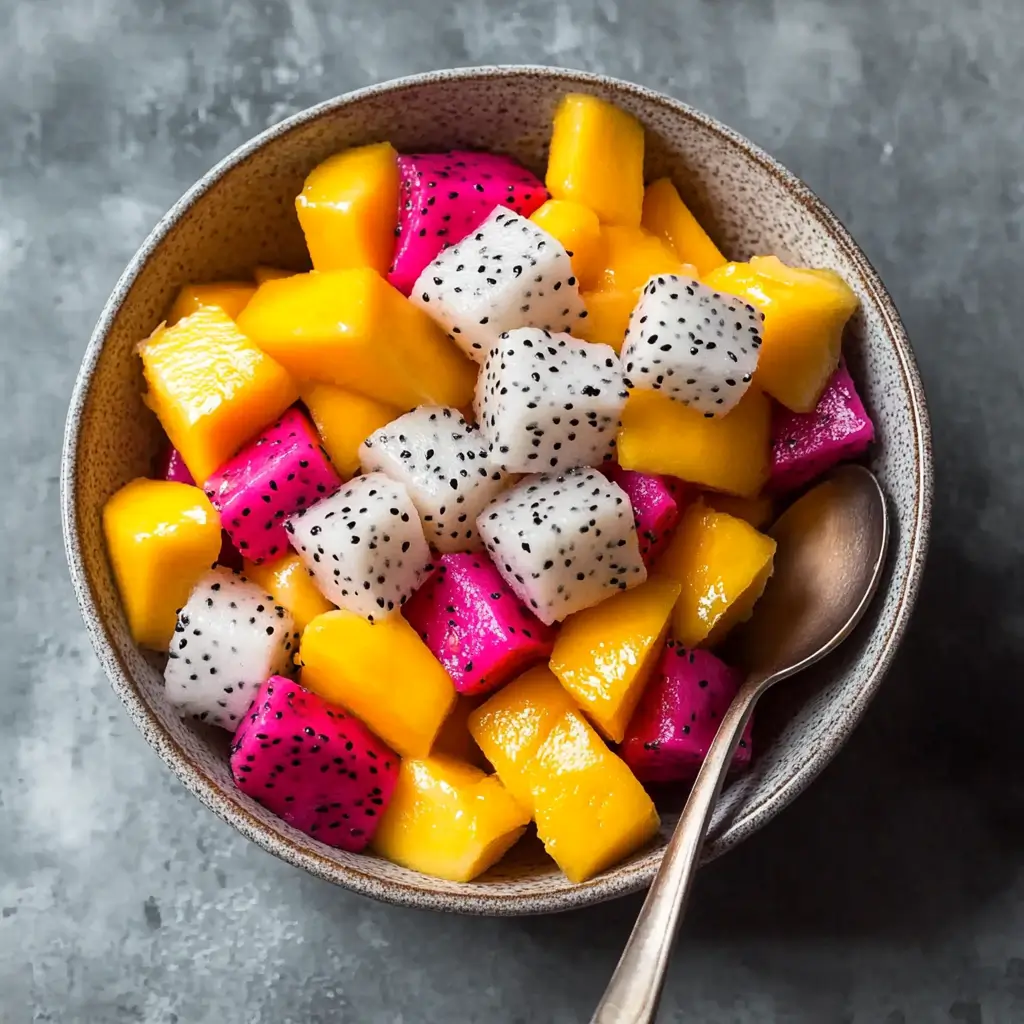
Some rare cases of allergic reactions have been reported, especially in people with sensitivities to tropical fruits or latex. If you experience itching, swelling, or any discomfort after eating pitaya, stop eating it and consult a doctor. These reactions are rare but worth noting.
Lastly, since yellow dragon fruit is hydrating and slightly laxative in nature, it’s best not to overdo it in one sitting. Just a few slices are usually enough to enjoy the benefits without any downsides. If you’re building a snack routine around tropical fruits, it’s good to rotate and balance them with protein-based options, like those featured in our balanced snack meal ideas.
For more recipes follow us in FACEBOOK
Conclusion
Pitaya yellow dragon fruit is one of those rare finds that’s as delicious as it is good for you. From its honey-sweet flavor and beautiful texture to its gut-friendly fiber and hydrating power, it’s the kind of fruit that can turn any snack into something special. Whether you’re slicing it fresh for a sunny afternoon treat or blending it into a smoothie bowl, it’s the perfect example of how simple ingredients can bring big joy.
If you’ve never tried yellow dragon fruit, now’s the time. Add it to your snack rotation and see how a little tropical flavor can brighten your day. And don’t forget-on SnacksPrep, you’ll always find more recipes, tips, and easy ideas to help you turn simple fruits like this one into something memorable.
What are the health benefits of yellow dragon fruit?
Yellow dragon fruit is packed with dietary fiber, antioxidants, vitamin C, and magnesium. It helps improve digestion, supports immune health, and aids hydration. Thanks to its high antioxidant content, it may also reduce oxidative stress and promote better skin. It’s a great low-calorie, naturally sweet snack that fits well into most balanced diets.
How do you eat yellow pitaya?
It’s incredibly easy to eat. Just cut the fruit in half lengthwise and scoop out the flesh with a spoon. You can enjoy it fresh, chilled, or diced in fruit salads. It also blends perfectly into smoothies or breakfast bowls. Since the skin isn’t edible, discard it after scooping.
What makes yellow dragon fruit different from red dragon fruit?
While both are dragon fruits, the yellow variety is sweeter and more flavorful. It has a firmer texture and higher sugar content, making it more appealing to those who love sweeter fruits. Yellow pitaya also has more fiber and a slightly different nutrient profile than the red or pink varieties.
Can yellow pitaya cause side effects or allergies?
For most people, yellow dragon fruit is safe and well-tolerated. However, eating too much can cause mild digestive discomfort due to its fiber content. In rare cases, individuals with sensitivities to tropical fruits or latex may experience mild allergic reactions. It’s always wise to start with a small portion.
